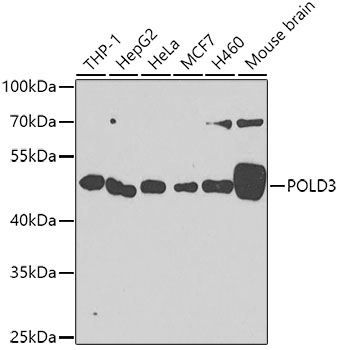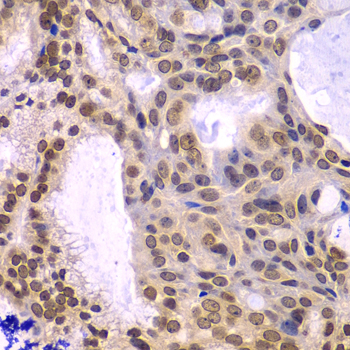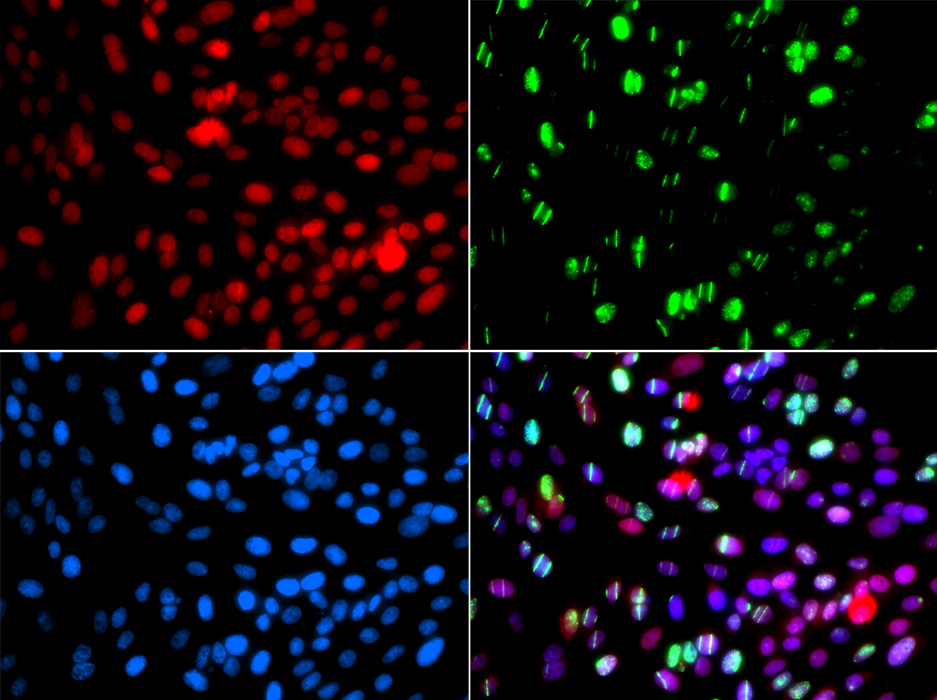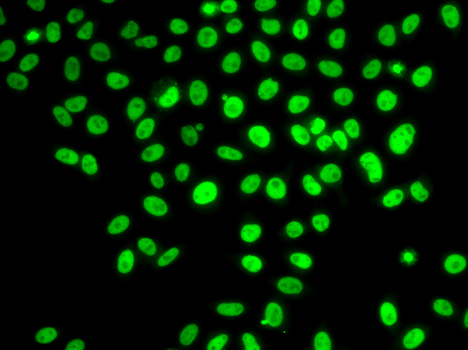-
Product Name
POLD3 Polyclonal Antibody
- Documents
-
Description
Polyclonal antibody to POLD3
-
Tested applications
WB, IHC, IF
-
Species reactivity
Human, Mouse
-
Alternative names
POLD3 antibody; P66 antibody; P68 antibody; PPP1R128 antibody; DNA polymerase delta subunit 3 antibody
-
Isotype
Rabbit IgG
-
Preparation
Antigen: Recombinant fusion protein containing a sequence corresponding to amino acids 197-466 of human POLD3 (NP_006582.1).
-
Clonality
Polyclonal
-
Formulation
PBS with 0.02% sodium azide, 50% glycerol, pH7.3.
-
Storage instructions
Store at -20℃. Avoid freeze / thaw cycles.
-
Applications
WB 1:500 - 1:2000
IHC 1:50 - 1:200
IF 1:50 - 1:100 -
Validations

Western blot - POLD3 Polyclonal Antibody
Western blot analysis of extracts of various cell lines, using POLD3 antibody at 1:1000 dilution.Secondary antibody: HRP Goat Anti-Rabbit IgG (H+L) at 1:10000 dilution.Lysates/proteins: 25ug per lane.Blocking buffer: 3% nonfat dry milk in TBST.Detection: ECL Enhanced Kit .Exposure time: 60s.

Immunohistochemistry - POLD3 Polyclonal Antibody
Immunohistochemistry of paraffin-embedded human oophoroma using POLD3 antibody at dilution of 1:100 (40x lens).

Immunofluorescence - POLD3 Polyclonal Antibody
Immunofluorescence analysis of GFP-RNF168 transgenic U2OS cells using POLD3 antibody . Greenuff1aGFP-RNF168 fusion protein expression for DNA damage marker.Blue: DAPI for nuclear staining.RNF168 can be used to mark cells damaged by UV-A laser for they always gather around DNA damage region.

Immunofluorescence - POLD3 Polyclonal Antibody
Immunofluorescence analysis of U2OS cells using POLD3 antibody .
-
Background
As a component of the trimeric and tetrameric DNA polymerase delta complexes (Pol-delta3 and Pol-delta4, respectively), plays a role in high fidelity genome replication, including in lagging strand synthesis, and repair. Required for optimal Pol-delta activity. Stabilizes the Pol-delta complex and plays a major role in Pol-delta stimulation by PCNA. Pol-delta3 and Pol-delta4 are characterized by the absence or the presence of POLD4. They exhibit differences in catalytic activity. Most notably, Pol-delta3 shows higher proofreading activity than Pol-delta4. Although both Pol-delta3 and Pol-delta4 process Okazaki fragments in vitro, Pol-delta3 may also be better suited to fulfill this task, exhibiting near-absence of strand displacement activity compared to Pol-delta4 and stalling on encounter with the 5'-blocking oligonucleotides. Pol-delta3 idling process may avoid the formation of a gap, while maintaining a nick that can be readily ligated. Along with DNA polymerase kappa, DNA polymerase delta carries out approximately half of nucleotide excision repair (NER) synthesis following UV irradiation. In this context, POLD3, along with PCNA and RFC1-replication factor C complex, is required to recruit POLD1, the catalytic subunit of the polymerase delta complex, to DNA damage sites. Under conditions of DNA replication stress, required for the repair of broken replication forks through break-induced replication (BIR). Involved in the translesion synthesis (TLS) of templates carrying O6-methylguanine or abasic sites performed by Pol-delta4, independently of DNA polymerase zeta (REV3L) or eta (POLH). Facilitates abasic site bypass by DNA polymerase delta by promoting extension from the nucleotide inserted opposite the lesion. Also involved in TLS, as a component of the POLZ complex. Along with POLD2, dramatically increases the efficiency and processivity of DNA synthesis of the minimal DNA polymerase zeta complex, consisting of only REV3L and REV7.
Related Products / Services
Please note: All products are "FOR RESEARCH USE ONLY AND ARE NOT INTENDED FOR DIAGNOSTIC OR THERAPEUTIC USE"
